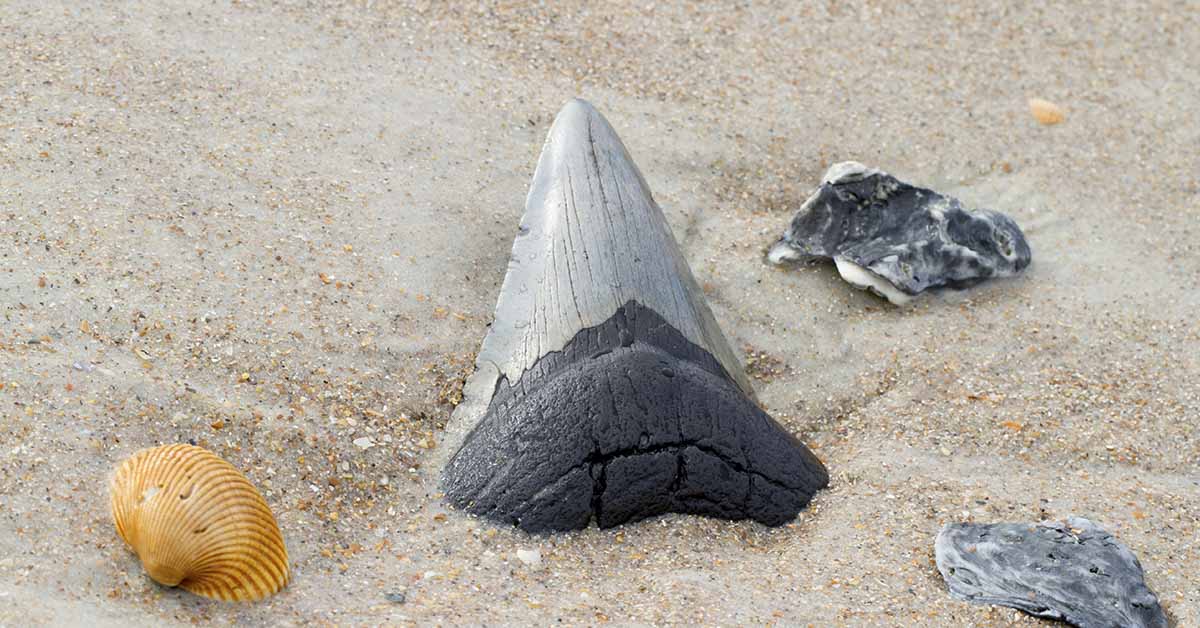A young girl found a tooth from the extinct megalodon. Her mother, Alicia Sampson, took her daughters to the beach on Christmas after they begged to “go shark tooth hunting like professionals.” To her surprise, they succeeded. Nine-year-old Molly had even declared she would be “looking for a Meg” in the car ride over. Several hours later, she found a shark tooth as large as her hand.
Finding a Megalodon Tooth on the “Best Christmas Ever”
The waters were freezing on Christmas morning and it was only 10 degrees outside but the low tides were optimal for fossil hunting. “The only thing Molly really wanted for Christmas was insulated chest waders because she knew she was missing out on some good fossil finds further out in the water,” Sampson said. “…As soon as they finished breakfast they got their waders on as quick as they could and headed to the cliffs with my husband Bruce.” [1]
By 10 a.m. Molly achieved her wish of finding a tooth from a megalodon. “She told me she was wading in knee deep water when she saw it and dove in to get it,” Sampson said. “She said she got her arms all wet, but it was so worth it. The look on her face is the only thing that makes me regret not going with them because I can’t even imagine the shriek that came from her mouth.”
The family brought the tooth to the Calvert Marine Museum to confirm the tooth’s authenticity. The museum posted about the find on Facebook, calling Molly a “future paleontologist.” In her own Facebook post, Sampson assumes this is “best Christmas ever” for Molly. “…This tooth was in the water, so thanks to the waders she got the best part of her present!”
A “once-in-a-lifetime kind of find”
Bruce Sampson had been hunting for fossils along Chesapeake Bay since his own childhood. Like Molly, he had dreamed of finding a large tooth. But his largest find was about 3 inches, and looks tiny compared to his daughter’s. “[Molly] has found over 400 teeth in her 9 years, ranging from teeny tiny to an inch or two — and now with this one, which is 5 inches,” Sampson said. “… she has always wanted to find a ‘Meg,’ but for whatever reason, she spoke it into existence on Christmas morning.” Molly is an aspiring paleontologist who is interested in all fossils, not just shark teeth.
Stephen Godfrey, curator of paleontology at the Calvert Marine Museum, calls Molly’s a “once-in-a-lifetime kind of find”. He states that the tooth must’ve come from the left side of the shark’s upper jaw. “People should not get the impression that teeth like this one are common along Calvert Cliffs.” Godfrey added that Molly found the tooth on a private beach. “…And she didn’t have to dig into the cliffs to find the tooth (which could be dangerous) it was out in the water. Her find is wonderful because she has an interest in paleontology and this will propel her and others her age to explore the sciences!” [2]
More About the Megaladon
The extinct megalodon used to be the largest shark on Earth. It was also one of the largest fish that had ever existed. Scientists have estimated its length to be up to 60 feet long (18 meters). That’s three times longer than the largest great white shark on record. This estimation is based on the size of its teeth; in fact, megaladon literally means ‘large tooth’.
The teeth also hint at the creature’s diet, which probably included other large marine animals like dolphins and whales. The megalodon would use its 276 serrated teach to bite the flipper and tail to disable their prey before going in for the kill. Researchers believe these sharks hunted in warm seas and their extinction occurred as the seas dried up and the ice age started. Their teeth have been found on every continent in the world except for Antarctica. [3]
Sharks, not just megaladons, shed teeth like humans shed hair. They produce teeth through their lives and they tend to lose a set of teeth every couple of weeks depending on what they consume. This is why shark teeth are so frequently discovered. They are also the hardest part of sharks, whose skeletons are made from cartilage instead of bone.
But here’s the most pressing question about the megalodon: Is it possible it still exists? “No. It’s definitely not alive in the deep oceans, despite what the Discovery Channel has said in the past,” said Emma Bernard, fossil fish curator at the National History Museum. “If an animal as big as megalodon still lived in the oceans we would know about it.”Their marks would appear all over, like large bite marks on other animals and thousands of their large teeth all over the ocean floor. Plus, they are a warm-water species and would need to stay closer to shore to survive. So there’s no chance they’re hiding unnoticed in the Mariana Trench. [4]
Sources
- “Maryland girl finds “once-in-a-lifetime” shark tooth from ancient 50-foot megalodon.” CBS News. Li Cohen. January 10, 2023
- “Girl, nine, finds megalodon shark tooth on Maryland beach.” BBC. Sam Cabral. January 14, 2023
- “Megalodon: Facts about the long-gone, giant shark.” Live Science. Alina Bradford. November 17, 2021
- “Megalodon: the truth about the largest shark that ever lived.” Natural History Museum. Josh Davis.

